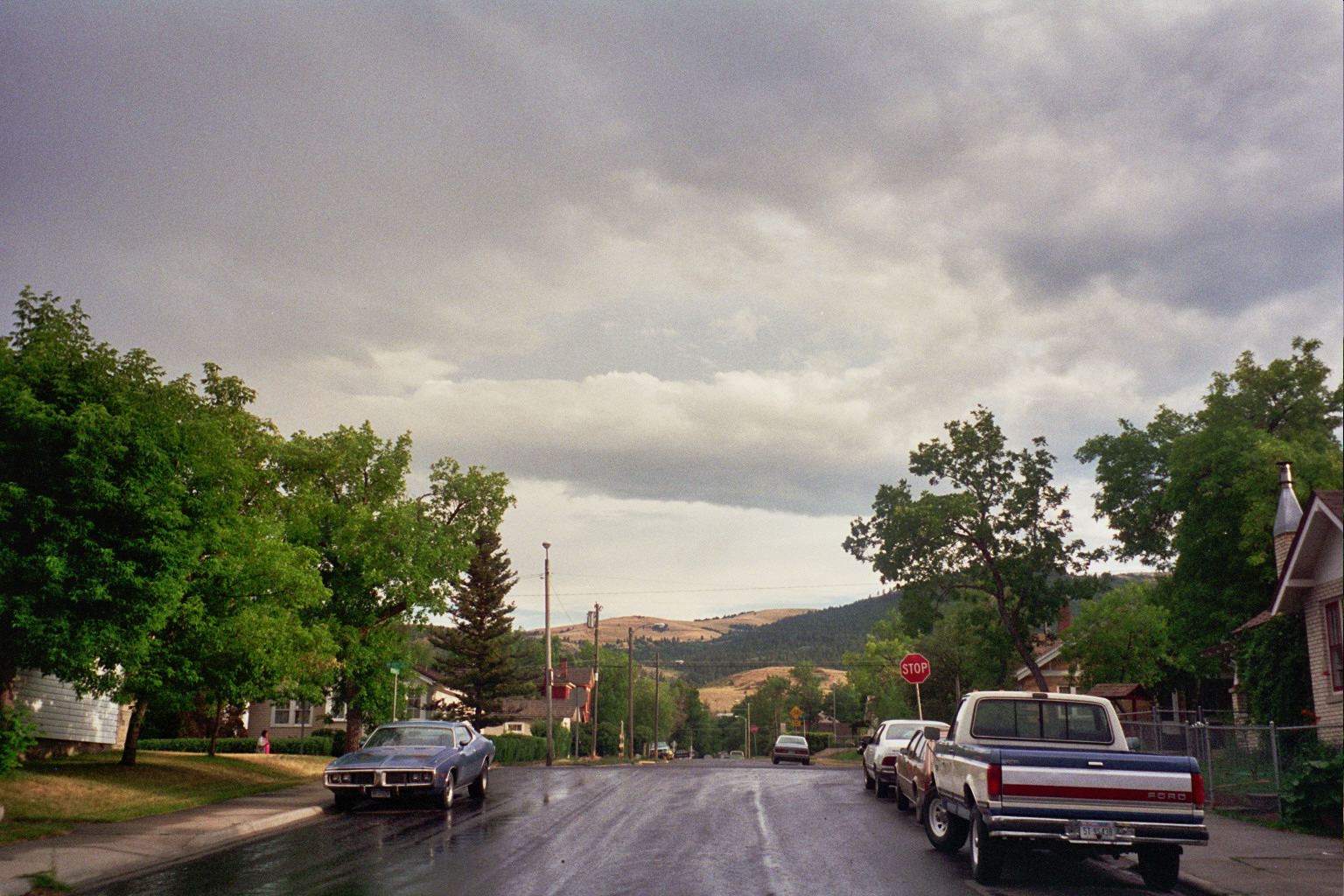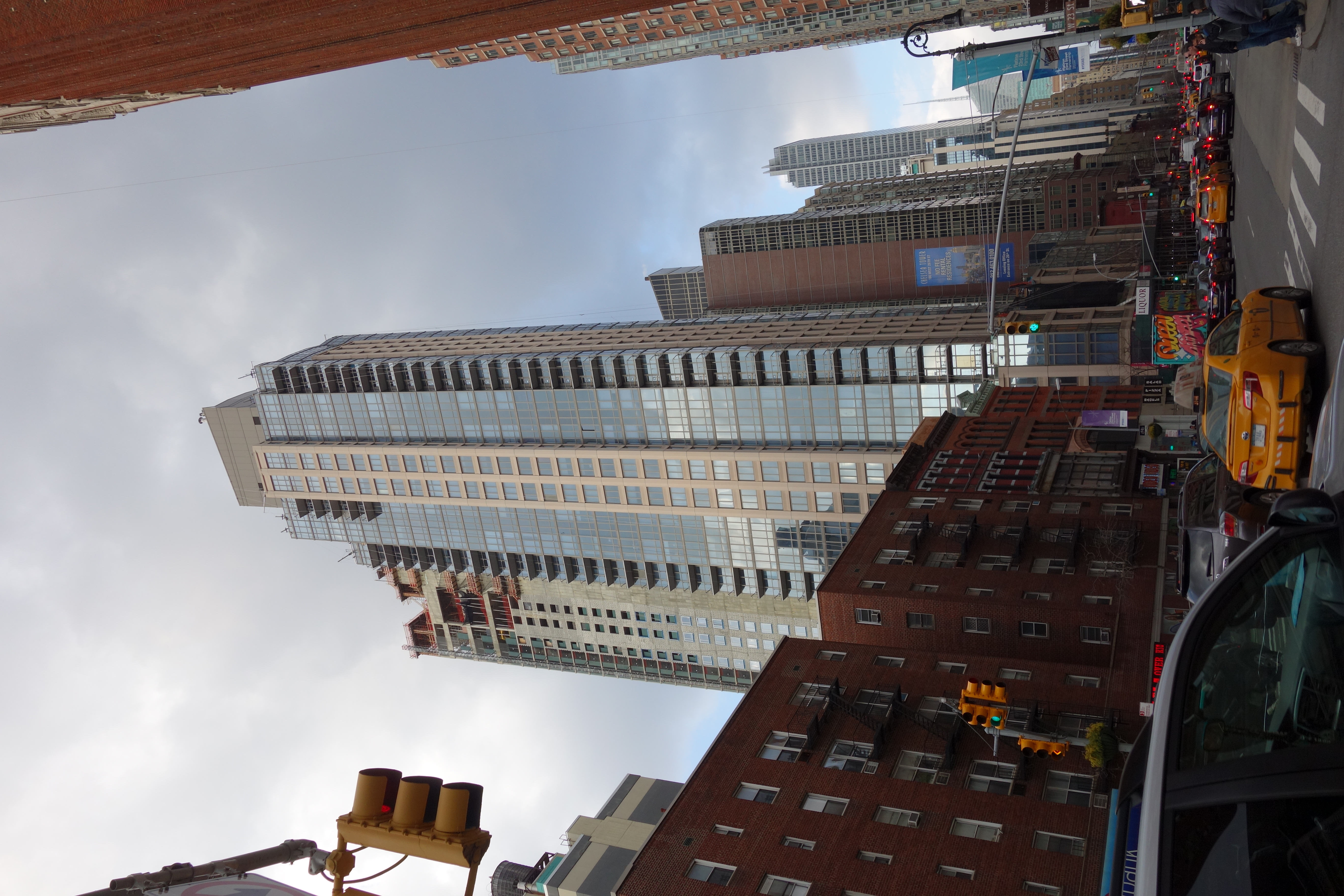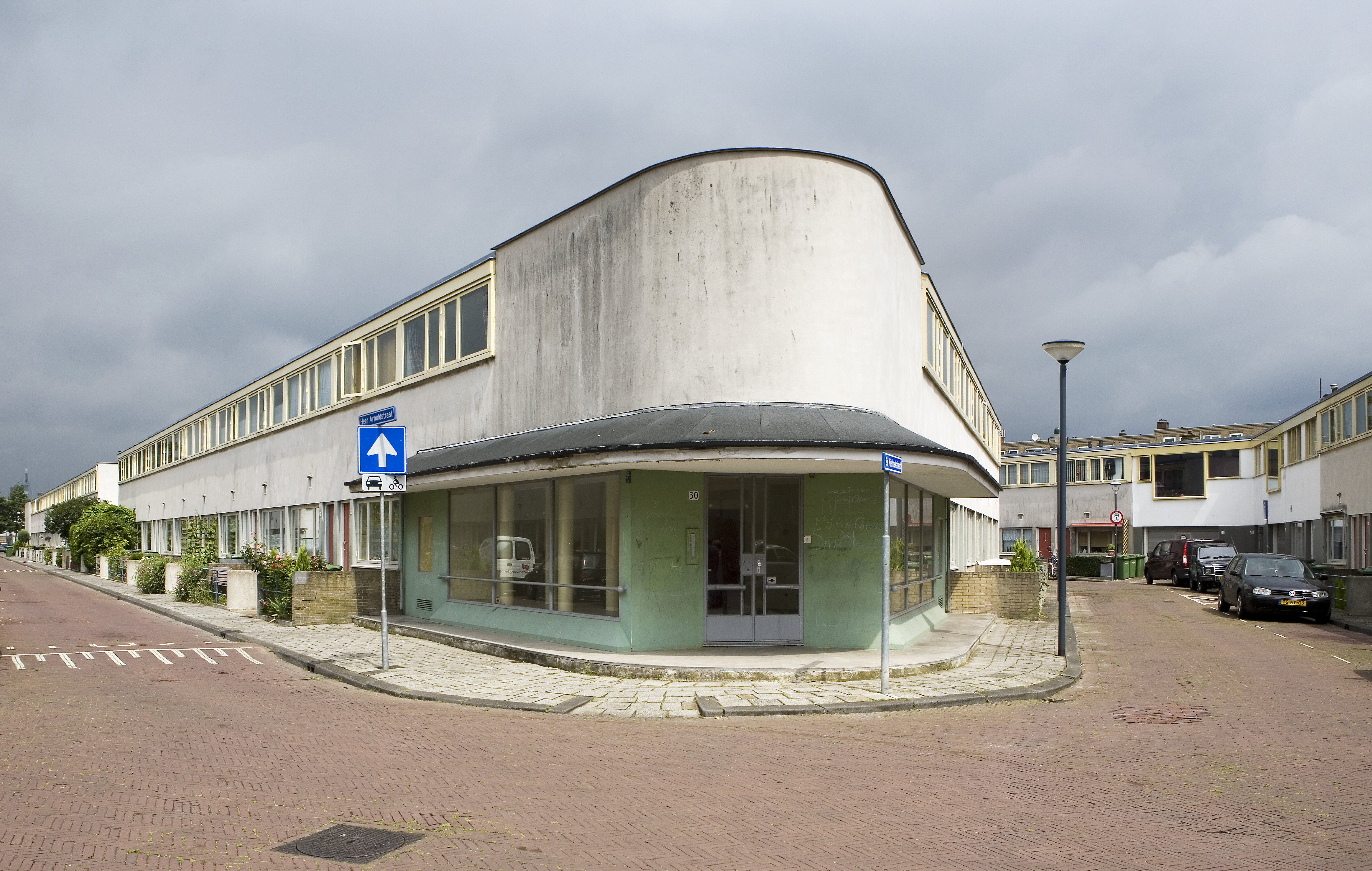|
Landfair Apartments
The Landfair Apartments is a historic two-building multi-family complex located on the southwest corner of Landfair Avenue and Ophir Drive in the Westwood neighborhood of Los Angeles, California. They were colloquially known as The Glass House and was renamed Robison Hall after UCHA member Everett Robison was drafted and killed in action in World War II. The building is a part of a collection of homes designed by Los Angeles based modernist architect, Richard Neutra, and built in North West Westwood Village, which includes the Strathmore Apartments, Elkay Apartments, and Kelton Apartments. Architectural historians Robert Winter and David Gebhard has said that the Landfair Apartments is Neutra's "most International Style designs...of the 1930s." History It was designed in 1937 by Neutra in the International style. It originally consisted of five townhouses and two apartments and was purchased in 1941 by the University Cooperative Housing Association. The balconies and exterior ... [...More Info...] [...Related Items...] OR: [Wikipedia] [Google] [Baidu] |
Los Angeles, California
Los Angeles, often referred to by its initials L.A., is the List of municipalities in California, most populous city in the U.S. state of California, and the commercial, Financial District, Los Angeles, financial, and Culture of Los Angeles, cultural center of Southern California. With an estimated 3,878,704 residents within the city limits , it is the List of United States cities by population, second-most populous in the United States, behind only New York City. Los Angeles has an Ethnic groups in Los Angeles, ethnically and culturally diverse population, and is the principal city of a Metropolitan statistical areas, metropolitan area of 12.9 million people (2024). Greater Los Angeles, a combined statistical area that includes the Los Angeles and Riverside–San Bernardino metropolitan areas, is a sprawling metropolis of over 18.5 million residents. The majority of the city proper lies in Los Angeles Basin, a basin in Southern California adjacent to the Pacific Ocean in the ... [...More Info...] [...Related Items...] OR: [Wikipedia] [Google] [Baidu] |
David Gebhard
David Stanley Gebhard (21 July 1927 – 3 March 1996) was a leading architectural historian, particularly known for his books on the architecture and architects of California. He was a long-time faculty member at the University of California, Santa Barbara, and was dedicated to the preservation of Santa Barbara architecture. Gebhard was also known for his archaeological work recording and documenting the multiple styles of pictographs in the Lower Pecos Canyonlands on the border of Texas and Mexico. Early life Gebhard was born in Cannon Falls, Minnesota, to Walter J. Gebhard (1895–1980), a well equipment manufacturer, and Ann K. Olson (1898–1978). Gebhard received his Ph.D. at the University of Minnesota in 1958. While finishing his doctorate, he served, for six years, as director of the Roswell Museum and Art Center in New Mexico, before moving to UC Santa Barbara in 1961. Career As a teacher he inspired many students at both the undergraduate and graduate levels. In a ... [...More Info...] [...Related Items...] OR: [Wikipedia] [Google] [Baidu] |
Los Angeles Historic-Cultural Monuments
Los Angeles Historic-Cultural Monuments are sites which have been designated by the Los Angeles, California, Cultural Heritage Commission as worthy of preservation based on architectural, historic and cultural criteria. History The Historic-Cultural Monument process has its origin in the Historic Buildings Committee formed in 1958 by the Los Angeles chapter of the American Institute of Architects. As growth and development in Los Angeles threatened the city's historic landmarks, the committee sought to implement a formal preservation program in cooperation with local civic, cultural and business organizations and municipal leaders. On April 30, 1962, a historic preservation ordinance proposed by the AIA committee was passed. The original Cultural Heritage Board (later renamed a commission) was formed in the summer of 1962, consisting of William Woollett, FAIA, Bonnie H. Riedel, Carl Dentzel, Carl S. Dentzel, Senaida Sullivan and Edith Gibbs Vaughan. The board met for the first ... [...More Info...] [...Related Items...] OR: [Wikipedia] [Google] [Baidu] |
Residential Buildings Completed In 1937
A residential area is a land used in which housing predominates, as opposed to industrial and commercial areas. Housing may vary significantly between, and through, residential areas. These include single-family housing, multi-family residential, or mobile homes. Zoning for residential use may permit some services or work opportunities or may totally exclude business and industry. It may permit high density land use or only permit low density uses. Residential zoning usually includes a smaller FAR (floor area ratio) than business, commercial or industrial/manufacturing zoning. The area may be large or small. Overview In certain residential areas, especially rural, large tracts of land may have no services whatever, such that residents seeking services must use a motor vehicle or other transportation, so the need for transportation has resulted in land development following existing or planned transport infrastructure such as rail and road. Development patterns may be regul ... [...More Info...] [...Related Items...] OR: [Wikipedia] [Google] [Baidu] |
Apartment Buildings In Los Angeles
An apartment (American English, Canadian English), flat (British English, Indian English, South African English), tenement ( Scots English), or unit (Australian English) is a self-contained housing unit (a type of residential real estate) that occupies part of a building, generally on a single story. There are many names for these overall buildings (see below). The housing tenure of apartments also varies considerably, from large-scale public housing, to owner occupancy within what is legally a condominium ( strata title or commonhold) or leasehold, to tenants renting from a private landlord. Terminology The term ''apartment'' is favoured in North America (although in some Canadian cities, ''flat'' is used for a unit which is part of a house containing two or three units, typically one to a floor). In the UK and Australia, the term ''apartment'' is more usual in professional real estate and architectural circles where otherwise the term ''flat'' is used commonly, but not ... [...More Info...] [...Related Items...] OR: [Wikipedia] [Google] [Baidu] |
Richard Neutra Buildings
Richard is a male given name. It originates, via Old French, from Old Frankish and is a compound of the words descending from Proto-Germanic language">Proto-Germanic ''*rīk-'' 'ruler, leader, king' and ''*hardu-'' 'strong, brave, hardy', and it therefore means 'strong in rule'. Nicknames include "Richie", " Dick", "Dickon", " Dickie", "Rich", "Rick", "Rico (name), Rico", " Ricky", and more. Richard is a common English (the name was introduced into England by the Normans), German and French male name. It's also used in many more languages, particularly Germanic, such as Norwegian, Danish, Swedish, Icelandic, and Dutch, as well as other languages including Irish, Scottish, Welsh and Finnish. Richard is cognate with variants of the name in other European languages, such as the Swedish "Rickard", the Portuguese and Spanish "Ricardo" and the Italian "Riccardo" (see comprehensive variant list below). People named Richard Multiple people with the same name * Richard Andersen ( ... [...More Info...] [...Related Items...] OR: [Wikipedia] [Google] [Baidu] |
List Of Los Angeles Historic-Cultural Monuments On The Westside
This is a List of Los Angeles Historic-Cultural Monuments on the Westside. In total, there are more than 85 Los Angeles Historic-Cultural Monuments, Historic-Cultural Monuments (HCM) on the Westside, and a handful of additional sites that have been recognized by the Cultural Heritage Commission for having been designated as California Historical Landmarks or having been listed on the National Register of Historic Places. They are designated by the city's Cultural Heritage Commission. Overview of the Westside's Historic-Cultural Monuments As a more recently developed section of the city, the Westside initially lagged behind other parts of the city in the designation of HCMs. In the first 20 years of the Cultural Heritage Commission's existence (August 1962 - August 1982), only three buildings (and three trees or groups of trees) on the Westside were designated as Historic-Cultural Monuments. The three buildings so designated are: (1) Rocha House -- (2) Hangar No. 1 -- the first ... [...More Info...] [...Related Items...] OR: [Wikipedia] [Google] [Baidu] |
Los Angeles Historic-Cultural Monument
Los Angeles Historic-Cultural Monuments are sites which have been designated by the Los Angeles, California, Cultural Heritage Commission as worthy of preservation based on architectural, historic and cultural criteria. History The Historic-Cultural Monument process has its origin in the Historic Buildings Committee formed in 1958 by the Los Angeles chapter of the American Institute of Architects. As growth and development in Los Angeles threatened the city's historic landmarks, the committee sought to implement a formal preservation program in cooperation with local civic, cultural and business organizations and municipal leaders. On April 30, 1962, a historic preservation ordinance proposed by the AIA committee was passed. The original Cultural Heritage Board (later renamed a commission) was formed in the summer of 1962, consisting of William Woollett, FAIA, Bonnie H. Riedel, Carl S. Dentzel, Senaida Sullivan and Edith Gibbs Vaughan. The board met for the first time in Augu ... [...More Info...] [...Related Items...] OR: [Wikipedia] [Google] [Baidu] |
Glazing (window)
Glazing, which derives from the Middle English for 'glass', is a part of a wall or window, made of glass. Glazing also describes the work done by a professional "glazier". Glazing is also less commonly used to describe the insertion of ophthalmic lenses into an eyeglass frame. Common types of glazing that are used in architectural applications include clear and tinted float glass, tempered glass, and laminated glass as well as a variety of coated glasses, all of which can be glazed singly or as Insulated glazing, double, or even triple, glazing units. Ordinary clear glass has a slight green tinge, but special colorless glasses are offered by several manufacturers. Glazing can be mounted on the surface of a window Sash window, sash or door Frame and panel, stile, usually made of wood, aluminium or Polyvinyl chloride, PVC. The glass is fixed into a rabbet, rabbet (rebate) in the frame in a number of ways including triangular glazing points, putty, etc. Toughened and laminated glas ... [...More Info...] [...Related Items...] OR: [Wikipedia] [Google] [Baidu] |
International Style (architecture)
The International Style is a major architectural style and movement that began in western Europe in the 1920s and dominated modern architecture until the 1970s. It is defined by strict adherence to Functionalism (architecture), functional and Form follows function, utilitarian designs and construction methods, typically expressed through minimalism. The style is characterized by Modular building, modular and Rectilinear polygon, rectilinear forms, Plane (mathematics), flat surfaces devoid of ornamentation and decoration, open and airy interiors that blend with the exterior, and the use of glass, steel, and concrete. The International Style is sometimes called rationalist architecture and the modern movement, although the former is mostly used in English to refer specifically to either Rationalism (architecture), Italian rationalism or the style that developed in 1920s Europe more broadly. In continental Europe, this and related styles are variably called Functionalism (architectu ... [...More Info...] [...Related Items...] OR: [Wikipedia] [Google] [Baidu] |
Robert Winter
Dr. Robert W. Winter (July 17, 1924 - February 9, 2019) was an architectural historian. He was the Arthur G. Coons Professor of the History of Ideas, Emeritus, at Occidental College, Los Angeles. He is particularly known for his contributions to the history of the California branch of the Arts and Crafts Movement. Early life Winter was born in Indianapolis, Indiana in 1924. He received his undergraduate degree (A.B.) from Dartmouth College and his Ph.D. from Johns Hopkins University. Career Early in his career he taught at Dartmouth, at Bowdoin, and at the University of California, Los Angeles. He joined the faculty at Occidental in 1963 and retired in 1994. Winter lived in Pasadena in the Batchelder House that formerly belonged to tilemaker Ernest Batchelder, about whom he wrote the definitive Batchelder history, ''Batchelder Tilemaker'' (1999). Winter is the author of numerous books including ''The California Bungalow'' (1980) and ''American Bungalow Style'' (1996 ... [...More Info...] [...Related Items...] OR: [Wikipedia] [Google] [Baidu] |
Richard Neutra
Richard Joseph Neutra ( ; 8 April 1892 – 16 April 1970) was an Austrian-American architect. Living and building for most of his career in Southern California, he came to be considered a prominent and important modernist architect. His most notable works include the Kaufmann Desert House, in Palm Springs, California. Biography Neutra was born in Leopoldstadt, the second district of Vienna, Austria Hungary, on 8 April 1892, into a wealthy Jewish family. His Jewish-Hungarian father Samuel Neutra (1844–1920), was a proprietor of a metal foundry, and his mother, Elizabeth "Betty" Glaser Neutra (1851–1905) was a member of the IKG Wien. Richard had two brothers, who also emigrated to the United States, and a sister, Josephine Theresia "Pepi" Weixlgärtner, an artist who married the Austrian art historian Arpad Weixlgärtner and who later emigrated to Sweden. Her work can be seen at the Modern Art Museum in Stockholm. Neutra attended the Sophiengymnasium in Vienna until 1 ... [...More Info...] [...Related Items...] OR: [Wikipedia] [Google] [Baidu] |






